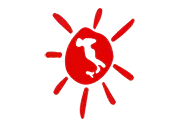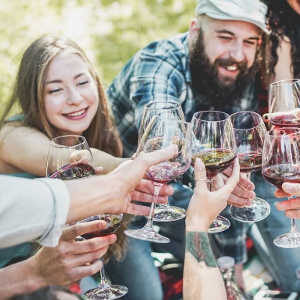Housing 60% of the world’s most important works of art, Florence is an art lover’s dream. Here are our must-see masterpieces from this beautiful city!
-
David by Michelangelo 1504 (Accademia Gallery)
Standing at 5.16m tall and weighing as much as 80 men, Michelangelo’s David is arguably one of the most famous sculptures in the world. Michelangelo made the statue from a single block of marble, the whitest in the world, brought over from the quarries in Carrara in Tuscany.
The solitary figure is that of David, the slayer of Goliath. While many artists portrayed David after his slaying of the giant, Michelangelo took a different approach, showing him before the battle. With a rock in his right hand, slingshot resting lightly on his left shoulder, and with a look of concentration on his face, he is ready to take on his foe.
-
Gates of Paradise by Ghiberti 1452 (The Baptistery of San Giovanni/Museo dell’Opera del Duomo)
Ghiberti made these gilded bronze doors for the north side of the Baptistery of San Giovanni in Florence. Following completion, they installed the doors at the east entrance, but they now reside in the Museo dell’Opera del Duomo. The doors currently at the Baptistry are replicas.
Each door contains five reliefs of scenes from the Old Testament and borders containing statuettes and busts. What Ghiberti achieved within the 10 panels on the doors is remarkable. He created an astounding sense of perspective, constructing 3D images that draw you into a detailed biblical scene.
Restoration works took place over 27 years, and in the early 21st century the museum unveiled the doors, gleaming as though freshly made. See them for yourself and understand why Michelangelo called them “so beautiful, they could be the gates of paradise”.
-
The Birth of Venus by Botticelli 1486 (Uffizi Gallery)
This icon of the Italian Renaissance is one of the most prized artworks in the Uffizi. The Roman Goddess of Love and Beauty arrives at the island of Cyprus on a scallop shell, looking as pure as a pearl. Pushed along by the breath of Zephyrus and offered a floral cloak by the figure thought of as Hora, the painting has a sense of movement and is reminiscent of springtime.
Botticelli used classical statues as inspiration for Venus’s pose, and he creates a sense of elegant modesty as he partially covers her nakedness with her hands and hair.
-
Tondo Doni by Michelangelo 1506 (Uffizi Gallery)
This artwork is the only intact panel painting that was painted entirely by Michelangelo. Depicting the Holy family and the infant Saint John, the artist created the piece after returning from Rome where he had carved the Pieta for the Vatican. Angelo Doni commissioned the piece, probably for a wedding or christening, but when he was sent the final painting, he tried to pay about half of what Michelangelo was asking. Michelangelo, unhappy with the payment offered, took the painting back and subsequently requested double the original amount from Doni. The powerful figures and colours in this painting, plus the frame which was likely designed by Michelangelo, make it a highlight of any trip to the Uffizi.
-
Medusa by Caravaggio 1598 (Uffizi)
This gruesome scene depicts the moment after Perseus executed the serpent-haired Medusa. The circular panel used for the painting is a shield, perfectly usable but never taken into battle. Caravaggio used the shield to echo the story of the beheading. Medusa was a fearsome figure who could turn victims to stone with her gaze, but Perseus used a shield to reflect her image back to her, causing paralysis. Exploiting Medusa’s paralysed state, Perseus struck the final, fatal blow. One of the most dramatic images in the Uffizi, Medusa will leave viewers with a lasting memory of the work of Caravaggio.
-
Rape of the Sabine Women by Giambologna 1583 (Loggia dei Lanzi) (Plaster model in the Accademia)
Giambologna may not be a household name like Michelangelo but his marble scene of the Rape of the Sabine women has influenced countless artists throughout history. Based on a story from the beginning of Rome, it shows the followers of Romulus as they steal the women from the Sabines while a chariot race distracted the men. Historians believe that no sexual assault took place during this raid, but Romans did abduct the women to help populate Rome.
Fascinating from every angle, make sure to walk around the statue, capturing the twisting, dynamic scene in all its glory. And if you would like to see one of the earlier plaster models made by Giambologna, this resides in the Accademia Gallery.
-
Pietá – by Michelangelo 1547-1555 (Opera Duomo Museum)
In a very different scene from the Pietá displayed in St Peter’s Basilica in Rome, this sculpture features 4 figures, as opposed to 2. The Virgin, Mary Magdalen and Nicodemus carry the dead body of Christ who has just been removed from the cross, supporting his lifeless body. The way in which Christ’s limp form falls and is caught by the surrounding figures emphasises the suffering of each of the subjects.
Rather than finishing it, Michelangelo abandoned this piece in 1555 after finding flaws in the marble. In his frustration, he mutilated the sculpture, and it remained in pieces until 1671 when the Grand Duke of Tuscany had it reconstructed.
-
David by Donatello 1440 (Bargello National Museum)
In stark contrast to Michelangelo’s imposing marble statue of David, Donatello’s creation is softer, creating an androgynous prepubescent form. David was a mere shepherd boy when he defeated the giant Goliath and this depiction of his body potentially represents a more accurate physique.
This statue achieved several firsts; it was the first bronze male nude and the first unsupported, free-standing statue since antiquity. The artwork represents how Florence saw itself, small but with a history of defending itself against larger, more powerful enemies.
-
Madonna of the Goldfinch by Raphael 1506 (Uffizi Gallery)
In this biblical scene, we see Saint John on the left holding out a goldfinch to the Christ child. The goldfinch is a symbol of the passion of Christ, of his suffering, and so the presentation of it to Jesus is like a prediction of his future. Despite the painful symbolism, the painting is sweet with children playing while under the watchful eye of Christ’s mother. Raphael also portrays a sense of wisdom in the face of Jesus by giving him a calm, all-knowing gaze. This painting shows the importance of religion at the time as well as the immense talent of Raphael.
Related article: Where to see the best art in Rome?




